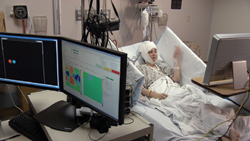
Test subject for brain-computer interface treatment of patients with spinal cord injuries. Photographs courtesy of the University of Pittsburgh, Pennsylvania.
Researchers at the University of Pittsburgh (Pitt), Pennsylvania, have been awarded funds for two projects that will place brain-computer interfaces (BCI) in patients with spinal cord injuries (SCI) to test their ability to control external devices, such as computer cursors or prosthetic limbs, with their thoughts. The projects build on ongoing research with epilepsy patients who have moved cursors and played computer games through the use of BCIs, as well as research with monkeys that have used a BCI to guide a robotic arm, according to a university press release.

Michael Boninger, MD
“We are now ready to begin testing BCI technology in the patients who might benefit from it the most, namely those who have lost the ability to move their upper limbs due to a spinal cord injury,” said Michael L. Boninger, MD, director of the University of Pittsburgh Medical Center (UPMC) Rehabilitation Institute, Pennsylvania, and chair of the Department of Physical Medicine and Rehabilitation, Pitt School of Medicine, a senior scientist on both projects. “It’s particularly exciting for us to be able to test two types of interfaces within the brain.”
“By expanding our research from the laboratory to clinical settings, we hope to gain a better understanding of how to train and motivate patients who will benefit from BCI technology,” said Elizabeth Tyler-Kabara, MD, PhD, a UPMC neurosurgeon and assistant professor of neurological surgery and bioengineering, Pitt Schools of Medicine and Engineering, and the lead surgeon on both projects.
The first project earned an $800,000 grant from the National Institutes of Health (NIH). Subjects with SCIs will host BCIs based on electrocorticography (ECoG) on the motor cortex surface of their brains for up to 29 days. The neural activity picked up by the BCI will be translated through a computer processor, allowing patients to learn to control computer cursors, virtual hands, computer games, and assistive devices such as prosthetic hands or wheelchairs.
The second project, funded by the Defense Advanced Research Projects Agency (DARPA) for up to $6 million over three years, is part of a program led by the Johns Hopkins University Applied Physics Laboratory (APL), Laurel, Maryland. Furthering the development of technology tested in monkeys by Andrew Schwartz, PhD, professor of neurobiology, Pitt School of Medicine, and also a senior investigator on both projects, researchers will implant an interface on the surface of the test subject’s brain in order to read individual neuron activity. Those signals will then be processed and relayed to maneuver a sophisticated prosthetic arm.
“Our animal studies have shown that we can interpret the messages the brain sends to make a simple robotic arm reach for an object and turn a mechanical wrist,” Schwartz said. “The next step is to see not only if we can make these techniques work for people, but also if we can make the movements more complex.”




